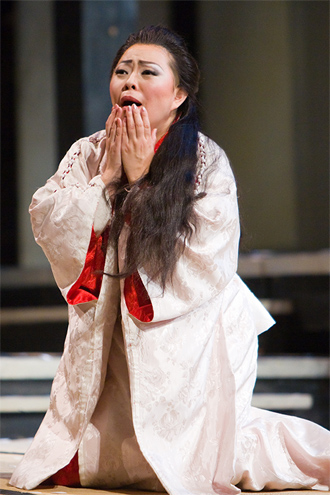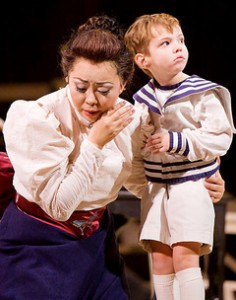 Opera Santa Barbara’s Artistic Director Jose Maria Condemi chats with soprano Mihoko Kinoshita, who takes on the title role of ‘Madame Butterfly’ this November.
Opera Santa Barbara’s Artistic Director Jose Maria Condemi chats with soprano Mihoko Kinoshita, who takes on the title role of ‘Madame Butterfly’ this November.
JMC: As a Japanese-born singer, how do you approach performing one of the Italian repertoire’s key roles, based on a character so close to your own culture?
MK: I think my interpretation of the character is changing; she’s not solely a Japanese character now. My first Cio-Cio-San was at the Santa Margherita Opera Festival in Italy; I created the character to be gentle and quiet – more traditionally Japanese. Then I lived in Italy for more than five years. After a few productions, I really started thinking about the text, which is so important to Italian opera – especially in Puccini’s work! I’m always thinking about the words; this is Italian music with Italian words. I’ve come to consider ‘Butterfly’ an Italian opera first, and a Japanese story second.
JMC: You’ve performed the role in Japan and in the United States. Do Western audiences have a different reaction to the opera than Japanese audiences? ??
MK: When I sang the role for the first time in the U.S., I was so surprised when I heard the audience laughing during the opera’s funny moments – Japanese audiences are not like that! American audiences really nestle up to a story; I love it!
JMC: Of the many production of ‘Madame Butterfly’ you’ve been a part of, which were the most interesting and revealing?
MK: My favorite production was by the Japanese director Kuriyama. It was so beautifully staged; the sets and movement were from Kabuki theatre, the stage was covered with cherry blossoms and the costume was an authentic geisha’s kimono. However, the most revealing production was by Jun Kaneko. It was a contemporary production that really made sense! I love modern interpretations when I fully understand the concept.
JMC: Which sopranos do you think have been particularly successful as Butterfly???
MK: Renata Scotto: I studied the role with her, and she gave me the most incredible insights. Cio-Cio-San’s feelings change dramatically over the course of the opera, and these changes happen quickly, especially in Acts II and III. These emotional transitions have to be made carefully. Also, Butterfly is a long role – more than two hours of singing! It’s so difficult to pace yourself; Scotto is the best.
JMC: One of the challenges in Butterfly is that you are working with a child actor who plays Butterfly’s son. Are you familiar with W.C. Fields’ quote, “never work with animals or children”? When I last directed ‘Butterfly’ for San Francisco Opera, the little boy fell soundly asleep on the soprano’s lap during the humming chorus – nothing could wake him! Eventually Suzuki had to lift him up and lay him on the floor so the staging could continue. Any amusing memories from rehearsal or performances that you could share?
 MK: That’s so cute! All the children I’ve worked with have been so lovely. When I sang ‘Butterfly” with Arizona Opera, I had a back condition and I couldn’t lift him in the performance; he was so angry with me because he thought I didn’t like him anymore – a real mother-son moment! In Michigan, the boy playing Trouble was so great and so sensitive. During the opera’s last moment he felt so sad that he began crying. He sobbed during the final good-bye and came back to give me an extra hug. It made such an impression on me… it’s one of the most special moments I’ve ever had onstage.
MK: That’s so cute! All the children I’ve worked with have been so lovely. When I sang ‘Butterfly” with Arizona Opera, I had a back condition and I couldn’t lift him in the performance; he was so angry with me because he thought I didn’t like him anymore – a real mother-son moment! In Michigan, the boy playing Trouble was so great and so sensitive. During the opera’s last moment he felt so sad that he began crying. He sobbed during the final good-bye and came back to give me an extra hug. It made such an impression on me… it’s one of the most special moments I’ve ever had onstage.


